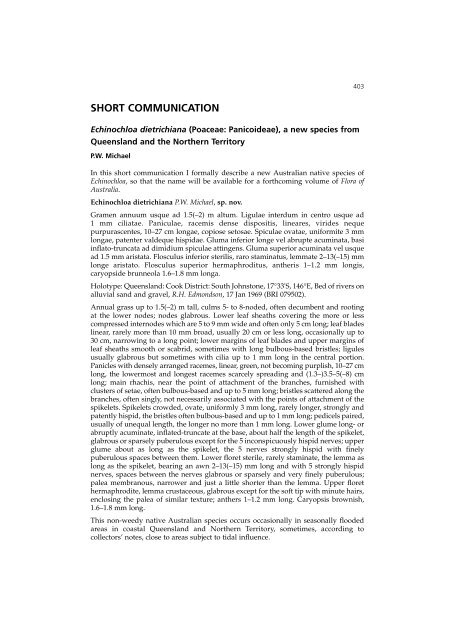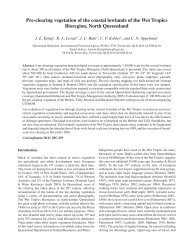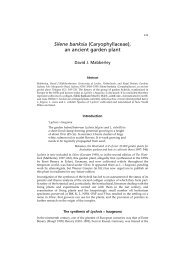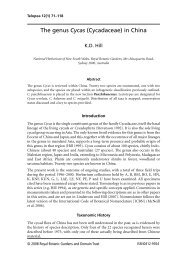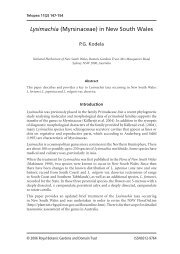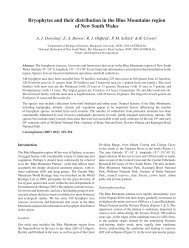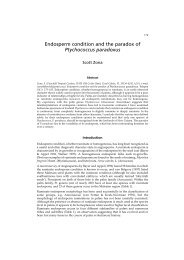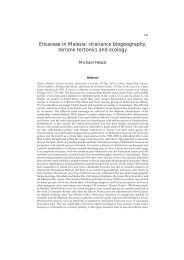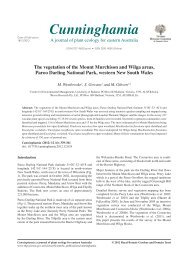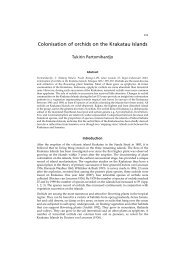Echinochloa dietrichiana
Echinochloa dietrichiana
Echinochloa dietrichiana
You also want an ePaper? Increase the reach of your titles
YUMPU automatically turns print PDFs into web optimized ePapers that Google loves.
SHORT COMMUNICATION<br />
<strong>Echinochloa</strong> <strong>dietrichiana</strong> (Poaceae: Panicoideae), a new species from<br />
Queensland and the Northern Territory<br />
P.W. Michael<br />
In this short communication I formally describe a new Australian native species of<br />
<strong>Echinochloa</strong>, so that the name will be available for a forthcoming volume of Flora of<br />
Australia.<br />
<strong>Echinochloa</strong> <strong>dietrichiana</strong> P.W. Michael, sp. nov.<br />
Gramen annuum usque ad 1.5(–2) m altum. Ligulae interdum in centro usque ad<br />
1 mm ciliatae. Paniculae, racemis dense dispositis, lineares, virides neque<br />
purpurascentes, 10–27 cm longae, copiose setosae. Spiculae ovatae, uniformite 3 mm<br />
longae, patenter valdeque hispidae. Gluma inferior longe vel abrupte acuminata, basi<br />
inflato-truncata ad dimidium spiculae attingens. Gluma superior acuminata vel usque<br />
ad 1.5 mm aristata. Flosculus inferior sterilis, raro staminatus, lemmate 2–13(–15) mm<br />
longe aristato. Flosculus superior hermaphroditus, antheris 1–1.2 mm longis,<br />
caryopside brunneola 1.6–1.8 mm longa.<br />
Holotype: Queensland: Cook District: South Johnstone, 17°33'S, 146°E, Bed of rivers on<br />
alluvial sand and gravel, R.H. Edmondson, 17 Jan 1969 (BRI 079502).<br />
Annual grass up to 1.5(–2) m tall, culms 5- to 8-noded, often decumbent and rooting<br />
at the lower nodes; nodes glabrous. Lower leaf sheaths covering the more or less<br />
compressed internodes which are 5 to 9 mm wide and often only 5 cm long; leaf blades<br />
linear, rarely more than 10 mm broad, usually 20 cm or less long, occasionally up to<br />
30 cm, narrowing to a long point; lower margins of leaf blades and upper margins of<br />
leaf sheaths smooth or scabrid, sometimes with long bulbous-based bristles; ligules<br />
usually glabrous but sometimes with cilia up to 1 mm long in the central portion.<br />
Panicles with densely arranged racemes, linear, green, not becoming purplish, 10–27 cm<br />
long, the lowermost and longest racemes scarcely spreading and (1.3–)3.5–5(–8) cm<br />
long; main rhachis, near the point of attachment of the branches, furnished with<br />
clusters of setae, often bulbous-based and up to 5 mm long; bristles scattered along the<br />
branches, often singly, not necessarily associated with the points of attachment of the<br />
spikelets. Spikelets crowded, ovate, uniformly 3 mm long, rarely longer, strongly and<br />
patently hispid, the bristles often bulbous-based and up to 1 mm long; pedicels paired,<br />
usually of unequal length, the longer no more than 1 mm long. Lower glume long- or<br />
abruptly acuminate, inflated-truncate at the base, about half the length of the spikelet,<br />
glabrous or sparsely puberulous except for the 5 inconspicuously hispid nerves; upper<br />
glume about as long as the spikelet, the 5 nerves strongly hispid with finely<br />
puberulous spaces between them. Lower floret sterile, rarely staminate, the lemma as<br />
long as the spikelet, bearing an awn 2–13(–15) mm long and with 5 strongly hispid<br />
nerves, spaces between the nerves glabrous or sparsely and very finely puberulous;<br />
palea membranous, narrower and just a little shorter than the lemma. Upper floret<br />
hermaphrodite, lemma crustaceous, glabrous except for the soft tip with minute hairs,<br />
enclosing the palea of similar texture; anthers 1–1.2 mm long. Caryopsis brownish,<br />
1.6–1.8 mm long.<br />
This non-weedy native Australian species occurs occasionally in seasonally flooded<br />
areas in coastal Queensland and Northern Territory, sometimes, according to<br />
collectors’ notes, close to areas subject to tidal influence.<br />
403
404 Telopea 8(3): 1999<br />
The epithet commemorates Amalie Dietrich (1821–1891), a remarkably skilful collector<br />
in the 1860s for the Hamburg merchants, J.C. Godeffroy and Son. Two of her<br />
specimens of this species from Rockhampton and near Mackay are in MEL.<br />
The current extent and conservation status of this species are unknown but it would<br />
appear to be quite vulnerable to competition from exotic perennial grasses. It is likely<br />
to have been overlooked by recent plant collectors due to its superficial resemblance<br />
to other species of <strong>Echinochloa</strong>, both native and exotic.<br />
Selected specimens: Queensland: Cook: Russells [Russell] River S. Johnson s.n., 1892 (MEL);<br />
Daintree River, Fitzalan s.n., 1875 (MEL); Cairns, White s.n., Jan 1918 (NSW 113462). North Kennedy:<br />
Cromarty, near Townsville, 20°43'S, 148°35'E, Blake 8292, Mar 1935 (BRI); ‘Toomba’, NW Charters<br />
Towers, 19°58'S, 145°36'E, Jacobs 8112, June 1996 (NSW); Don River, near Edgecombe Bay, Birch s.n.,<br />
1886 (MEL). South Kennedy: Bloomsbury about 50 miles [81 km] WNW Mackay, Thomsett s.n., May<br />
1969 (BRI 085751); prope Mackay, Dietrich 390, undated (MEL [ex Museo Godeffroy<br />
Hamburgensis]). Port Curtis: ‘Torilla’ between Broad Sound and Shoalwater Bay, 22°15'–20'S,<br />
150°04'E, Blake & Webb 15623, Apr 1945 (BRI); ‘Ubobo’, property of W. Wedge, Graham s.n., Apr 1958<br />
(BRI 008372); Rockhampton, O’Shanesy s.n., June 1867 (MEL); Gracemere, O’Shanesy 1631, Jan 1876<br />
(MEL); Rockhampton, Dietrich 1820, Feb 1866 (MEL); Bobs Creek, 17 miles [27.4 km] S of<br />
Rockhampton, Michael s.n., May 1972 (NSW 115945, BRI); Granite Creek c.45 km N of Marlborough,<br />
22°37'S, 149°32'E, Dalby 95/01 & Jacobs, Apr 1995 (NSW); Yeppoon Wetlands beyond Capricornia<br />
International Resort, Gray s.n., Aug 1995 (NSW 432046); Palm Creek, 23 km S of Miriam Vale, Bruce<br />
Hwy, Jacobs 2546 & Rodd, May 1976 (NSW). Wide Bay District: Maryborough, Blake 14331, Aug 1941<br />
(BRI). Moreton: Enoggera, near Brisbane, White s.n., Feb 1937 (BRI 070780).<br />
Northern Territory: Outflow of Overflow Creek, Litchfield, in perennial swamp, 13°18'S, 130°28'E,<br />
Russell-Smith 6007 & Lucas, Oct 1988 (DNA); Adelaide River, 12°42'S, 131°30'E, Wilson 420, Apr 1990<br />
(DNA).<br />
E. <strong>dietrichiana</strong> has been confused with two other annual taxa, namely, the native<br />
E. telmatophila P.W. Michael & Vickery and E. crus-galli (L.) P. Beauv. ssp. hispidula<br />
(Retz.) Honda, an important weed of rice especially in the Indian sub-continent, southeast<br />
Asia, China and Japan.<br />
The non-weedy nature of E. <strong>dietrichiana</strong>, its remarkably hispid spikelets and lack of<br />
purplish coloration in the inflorescence conveniently distinguish it from E. crus-galli<br />
ssp. hispidula in which, moreover, the panicle branches are less dense, the lower<br />
racemes often being whorled and somewhat spreading. The much less strongly hispid,<br />
elliptical spikelets of E. crus-galli ssp. hispidula are 3–4 mm long, the lower glume,<br />
which is often somewhat rounded at the base, is only one quarter to one third the<br />
length of the spikelet, while the awn of the sterile lemma is often between 20 and<br />
40 mm long. The anthers of the fertile floret are generally shorter (0.7–0.9 mm) than in<br />
E. <strong>dietrichiana</strong>.<br />
E. telmatophila is also non-weedy but its leaves are longer (often up to 35 cm) and<br />
broader (up to 18 mm) than in E. <strong>dietrichiana</strong> and its inflorescences are often purplish.<br />
The lower panicle branches are often longer (up to 10 cm) and its much less hispid<br />
spikelets, 3–4.2 mm long, are rather narrowly elliptical, gradually tapering towards<br />
the base. Awns arising from both the sterile lemma (up to 40 mm) and the upper glume<br />
(up to 7 mm) are much longer than in E. <strong>dietrichiana</strong>. Caryopses (1.8–2.3 mm), too,<br />
are longer.<br />
Acknowledgment<br />
I am especially grateful to Jan De Nardi who gave valuable early help in the tedious<br />
delineation of the distinguishing characters of the three taxa involved in this work.
Michael, <strong>Echinochloa</strong> <strong>dietrichiana</strong> sp. nov. 405<br />
P.W. Michael<br />
National Herbarium of NSW<br />
Mrs Macquaries Road<br />
Sydney NSW 2000<br />
Australia<br />
Manuscript received 15 July 1999<br />
Manuscript accepted 20 October 1999
145° 147° 149° 151° 153°<br />
QUEENSLAND<br />
141° 143°<br />
Richmond<br />
RIVER<br />
•LISMORE<br />
29°<br />
River<br />
NC<br />
CLARENCE<br />
•<br />
TENTERFIELD<br />
NWS<br />
•MOREE<br />
•<br />
Lightning<br />
Ridge<br />
River<br />
•Enngonia<br />
NT<br />
River<br />
29°<br />
NWP<br />
R iver<br />
•<br />
GRAFTON<br />
Tibooburra•<br />
RIVER<br />
•<br />
GLEN INNES<br />
BARWON<br />
Culgoa<br />
INVERELL•<br />
RIVER<br />
Wanggring•<br />
Narran L.<br />
NFWP<br />
SOUTH AUSTRALIA<br />
RIVER<br />
•Walgett<br />
BOURKE•<br />
W arrego<br />
NAMOI<br />
•Guvra<br />
•Dorrigo<br />
NARRABRI•<br />
Pilliga•<br />
•ARMIDALE<br />
Paroo<br />
The Salt Lake<br />
M acleay<br />
Byrock•<br />
R ive r<br />
•Baradine<br />
•COONAMBLE<br />
Tilpa•<br />
•<br />
KEMPSEY<br />
TAMWORTH•<br />
MACQUARIE<br />
DARLING<br />
•White Cliffs<br />
NWS<br />
•<br />
Coonabarabran<br />
NWP<br />
Lake Bancannia<br />
31°<br />
31°<br />
NT<br />
•NYNGAN<br />
COBAR•<br />
M ann ing River<br />
RIVER<br />
RIVER<br />
Wilcannia•<br />
NFWP<br />
TAREE•<br />
NC<br />
CWS<br />
•Nymagee<br />
•BROKEN HILL<br />
MUSWELLBROOK•<br />
HUNTER<br />
•MUDGEE<br />
SWP<br />
•Menindee<br />
RIVER<br />
SFWP<br />
•NEWCASTLE<br />
CT CC<br />
•Ivanhoe<br />
33°<br />
•Condoblin<br />
RIVER<br />
•BATHURST<br />
•ORANGE<br />
•FORBES<br />
River<br />
•<br />
Lake<br />
Cargelligo<br />
DARLING<br />
33°<br />
Hawkesbury<br />
•Hillston<br />
•Pooncane<br />
•<br />
•SYDNEY<br />
West Wyalong<br />
•Wentworth<br />
CC<br />
•GRIFFITH<br />
•TEMORA<br />
Moss Vale• •WOLLONGONG NC North Coast<br />
•Euston<br />
CC Central Coast<br />
•Balranald SWP •NARRANDERA<br />
GOULBURN•<br />
•<br />
NOWRA<br />
SC South Coast<br />
•<br />
WAGGA WAGGA ST<br />
NT Northern Tablelands<br />
Braidwood<br />
CT Central Tablelands<br />
•DENILIQUIN SWS<br />
• SC<br />
ST Southern Tablelands<br />
•<br />
Holbrook<br />
NWS North Western Slopes<br />
Miles<br />
20<br />
100<br />
COOMA•<br />
CWS Central Western Slopes<br />
Kilometres<br />
20 60 100<br />
SWS South Western Slopes<br />
ST<br />
Bega<br />
•<br />
NWP North Western Plains<br />
Bombala•<br />
BOTANICAL DIVISIONS AND<br />
SWP South Western Plains<br />
NFWP North Far Western Plains<br />
SUBDIVISIONS OF NEW SOUTH WALES<br />
SC<br />
SFWP South Far Western Plains<br />
•YOUNG<br />
Oxley•<br />
MURRUMBIDGEE<br />
•<br />
Hay<br />
35° •<br />
35°<br />
CANBERRA<br />
ALBURY<br />
•<br />
37°<br />
37°<br />
141° 143° 145° 147° 149° 151°<br />
CT<br />
CWS<br />
LACHLAN<br />
LACHLAN<br />
SFWP<br />
RIVER<br />
RIVER<br />
RIVER<br />
MURRAY RIVER<br />
River<br />
Wakool<br />
SHOALHAVEN<br />
RIVER<br />
MURRAY<br />
VICTORIA<br />
For explanation and description of the Botanical Divisions and Subdivisions of New South Wales<br />
see Anderson, R.H. (1961). Introduction. Cont. New South Wales. Natl. Herb. Fl. New South Wales<br />
Nos 1–18, pp. 1–15.


